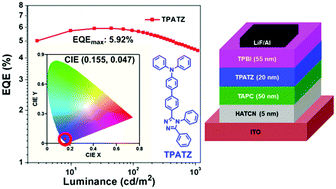A simple D–π–A hybrid mode for highly efficient non-doped true blue OLEDs with CIEy < 0.05 and EQE up to 6%†
Abstract
Although great advances have been achieved in organic electroluminescence fields, highly efficient true blue organic electroluminescence with small CIE coordinates and satisfactory color purity are still limited. Here, we practise a simple and effective molecular avenue for true blue organic electroluminescence, and the strategy is to use biphenyl-bridging hybrids of 1,2,4-triazoles (acceptors) and various donors (D) as the emitters. The as-prepared D–π–A hybrid (TPATZ) containing 2,3,4-triphenyl-1,2,4-triazole and triphenylamine emits bright blue light both in solution and in the solid state, and the non-doped device with TPATZ as an emitter exhibits true blue electroluminescence (EL) with the emission peak at 430 nm and the Commission Internationale de L’Eclairage coordinates of (0.155, 0.047). Moreover, the satisfactory EL color purity with the full width at half maximum (FWHM) of only 50 nm and the maximum external quantum efficiency of 5.92% is obtained, which is among the best true blue OLEDs reported to date. These impressive EL properties are experimentally and theoretically analyzed and emphasize that this simple D–π–A hybrid mode is an effective molecular strategy for highly efficient true blue EL emitters.



 Please wait while we load your content...
Please wait while we load your content...